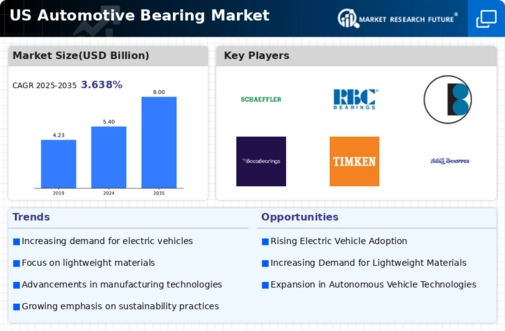Rising Vehicle Production
The automotive bearing market experiences growth driven by the increasing production of vehicles in the US. In recent years, the automotive industry has seen a steady rise in manufacturing output, with production levels reaching approximately 10 million units annually. This surge in vehicle production necessitates a corresponding demand for automotive bearings, which are essential components in various vehicle systems. As manufacturers strive to enhance vehicle performance and reliability, the need for high-quality bearings becomes paramount. Consequently, the automotive bearing market is likely to benefit from this upward trend in vehicle production, as more vehicles on the road translate to greater demand for replacement and aftermarket bearings.
Expansion of Aftermarket Services
The automotive bearing market is significantly influenced by the expansion of aftermarket services in the US. As vehicle ownership rates increase, the demand for maintenance and repair services rises correspondingly. This trend is particularly evident in the growing number of independent repair shops and service centers that cater to vehicle owners seeking quality replacement parts. The aftermarket segment for automotive bearings is projected to account for a substantial share of the overall market, with estimates suggesting it could reach $3 billion by 2026. This growth is indicative of a broader trend where consumers prioritize vehicle longevity and performance, thereby driving the demand for high-quality automotive bearings.
Growth of Electric Vehicle Market
The market is experiencing a transformation due to the growth of the electric vehicle (EV) market in the US. As consumer preferences shift towards electric mobility, the demand for specialized bearings that cater to the unique requirements of EVs is on the rise. Electric vehicles often require bearings that can withstand higher torque and operate efficiently under different conditions compared to traditional internal combustion engine vehicles. This shift is likely to create new opportunities for manufacturers within the automotive bearing market, as they adapt their product offerings to meet the evolving needs of the EV sector. The projected growth of the EV market, which is expected to reach 25% of total vehicle sales by 2030, further underscores the potential for expansion in the automotive bearing market.
Increased Focus on Fuel Efficiency
The automotive bearing market is positively impacted by the increased focus on fuel efficiency among vehicle manufacturers. As regulatory standards for emissions and fuel economy become more stringent, automakers are seeking ways to enhance the efficiency of their vehicles. Bearings play a crucial role in reducing friction and improving overall vehicle performance, which directly contributes to better fuel efficiency. The market is likely to benefit from this trend, as manufacturers invest in high-performance bearings designed to minimize energy loss. This shift towards fuel-efficient technologies is expected to drive innovation and demand within the automotive bearing market, aligning with the broader goals of sustainability and environmental responsibility.
Technological Innovations in Manufacturing
Technological innovations in manufacturing processes are reshaping the automotive bearing market. Advanced manufacturing techniques, such as additive manufacturing and precision machining, are enhancing the production of bearings, resulting in improved performance and durability. These innovations allow manufacturers to produce bearings that meet the stringent requirements of modern vehicles, which often feature higher speeds and loads. As a result, The market is likely to see an increase in demand for technologically advanced products that offer superior performance. Furthermore, the integration of smart technologies into bearings, such as sensors for monitoring wear and tear, is expected to create new opportunities for growth within the industry.




















Leave a Comment